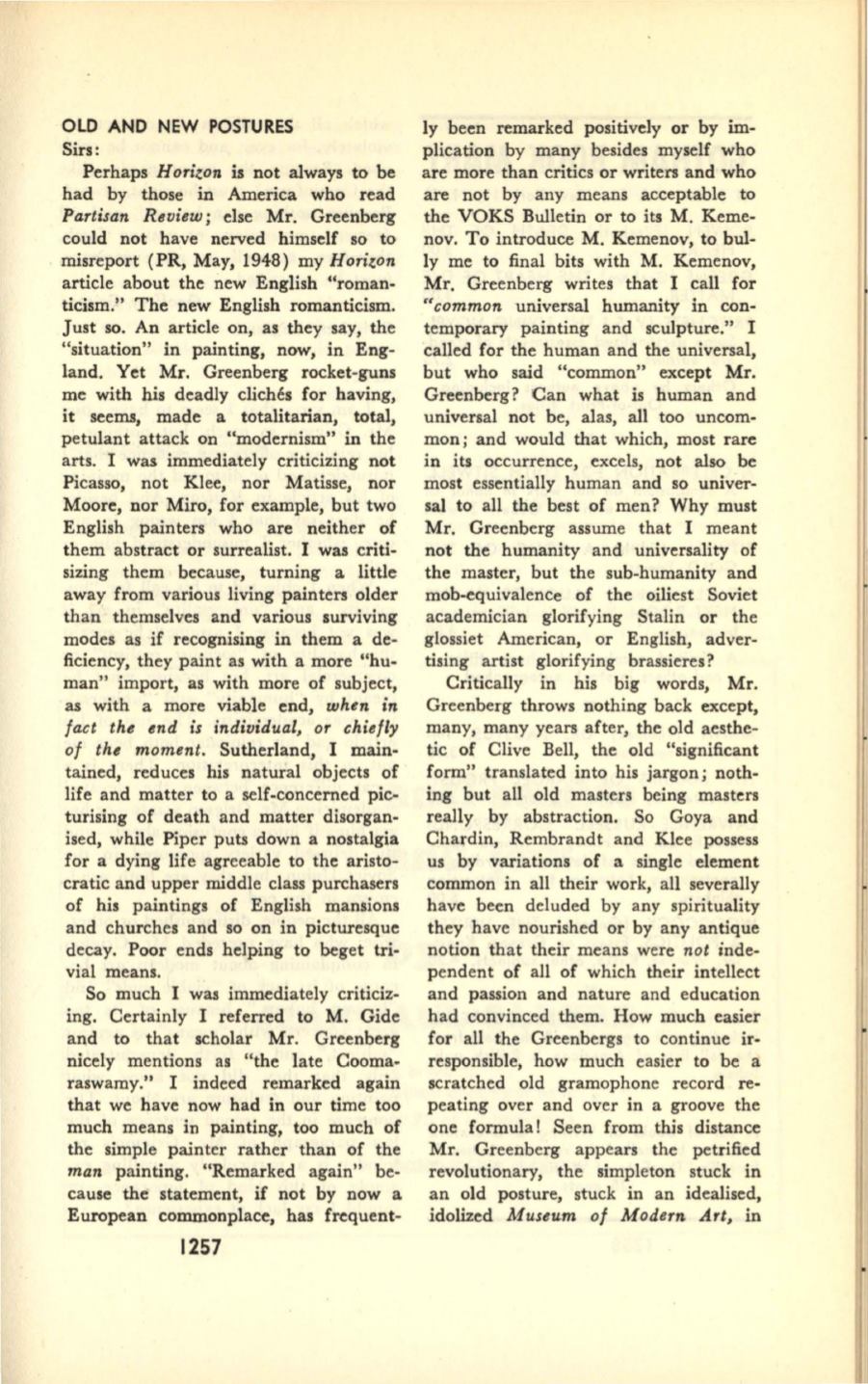
OLD AND NEW POSTURES
Sirs:
Perhaps
H oriz;on
is not always to be
had by those in America who read
Partisan R6view;
else Mr. Greenberg
could not have nerved himself so to
misreport (PR, May, 1948) my
Horiz;on
article about the new English "roman–
ticism." The new English romanticism.
Just so. An article on, as they say, the
"situation" in painting, now, in Eng–
land. Yet Mr. Greenberg rocket-guns
me with his deadly cliches for having,
it seems, made a totalitarian, total,
petulant attack on "modernism" in the
arts. I was immediately criticizing not
Picasso, not Klee, nor Matisse, nor
Moore, nor Miro, for example, but two
English painters who are neither of
them abstract or surrealist. I was criti–
sizing them because, turning a little
away from various living painters older
than themselves and various surviving
modes as if recognising in them a de–
ficiency, they paint as with a more "hu–
man" import, as with more of subject,
as with a more viable end,
when
in
fact the end is individual, or chiefly
of the moment.
Sutherland, I main–
tained, reduces his natural objects of
life and matter to a self-concerned pic–
turising of death and matter disorgan–
ised, while Piper puts down a nostalgia
for a dying life agreeable to the aristo–
cratic and upper middle class purchasers
of his paintings of English mansions
and churches and so on in picturesque
decay. Poor ends helping to beget tri–
vial means.
So much I was immediately criticiz–
ing. Certainly I referred to M. Gide
and to that scholar Mr. Greenberg
nicely mentions as "the late Cooma–
raswamy." I indeed remarked again
that we have now had in our time too
much means in painting, too much of
the simple painter rather than of the
man
painting. "Remarked again" be–
cause the statement, if not by now a
European commonplace, has frequent-
1257
ly been remarked positively or by
im–
plication by many besides myself who
are more than critics or writers and who
are not by any means acceptable to
the VOKS Bulletin or to its M. Keme–
nov. To introduce M. Kemenov, to bul–
ly me to final bits with M. Kemenov,
Mr. Greenberg writes that I call for
"common
universal humanity in con–
temporary painting and sculpture." I
called for the human and the universal,
but who said "common" except Mr.
Greenberg? Can what is human and
universal not be, alas, all too uncom–
mon; and would that which, most rare
in its occurrence, excels, not also be
most essentially human and so univer–
sal to all the best of men? Why must
Mr. Greenberg assume that I meant
not the humanity and universality of
the master, but the sub-humanity and
mob-equivalence of the oiliest Soviet
academician glorifying Stalin or the
glossiet American, or English, adver–
tising artist glorifying brassieres?
Critically in his big words, Mr.
Greenberg throws nothing back except,
many, many years after, the old aesthe–
tic of Clive Bell, the old "significant
form" translated into his jargon; noth–
ing but all old masters being masters
really by abstraction. So Goya and
Chardin, Rembrandt and Klee possess
us by variations of a single element
common in all their work, all severally
have been deluded by any spirituality
they have nourished or by any antique
notion that their means were
not
inde–
pendent of all of which their intellect
and passion and nature and education
had convinced them. How much easier
for all the Greenbergs to continue ir–
responsible, how much easier to be a
scratched old gramophone record re–
peating over and over in a groove the
one formula! Seen from this distance
Mr. Greenberg appears the petrified
revolutionary, the simpleton stuck in
an old posture, stuck in an idealised,
idolized
Museu-m of Modern Art,
in


